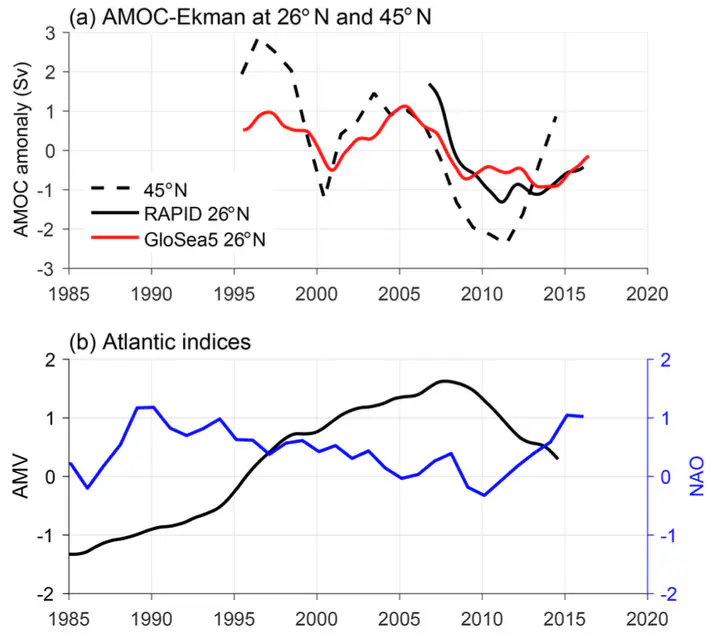Pending recovery in the strength of the meridional overturning circulation at 26°N
 (a) AMOC anomalies from RAPID at 26◦ N (black, Sv), 26◦ N GloSea5 reanalysis (red, Sv), AMOC 45◦ N (black dashed, Sv). (b) The AMV (black) and NAO (blue). The AMV has been decadally low-pass filtered, with a 5-year low-pass filter applied to the NAO time series. The Ekman transport has been removed from the AMOC time series.
(a) AMOC anomalies from RAPID at 26◦ N (black, Sv), 26◦ N GloSea5 reanalysis (red, Sv), AMOC 45◦ N (black dashed, Sv). (b) The AMV (black) and NAO (blue). The AMV has been decadally low-pass filtered, with a 5-year low-pass filter applied to the NAO time series. The Ekman transport has been removed from the AMOC time series.
Abstract
The strength of the Atlantic meridional overturning circulation (AMOC) at 26∘ N has now been continuously measured by the RAPID array over the period April 2004–September 2018. This record provides unique insight into the variability of the large-scale ocean circulation, previously only measured by sporadic snapshots of basin-wide transport from hydrographic sections. The continuous measurements have unveiled striking variability on timescales of days to a decade, driven largely by wind forcing, contrasting with previous expectations about a slowly varying buoyancy-forced large-scale ocean circulation. However, these measurements were primarily observed during a warm state of the Atlantic multidecadal variability (AMV) which has been steadily declining since a peak in 2008–2010. In 2013–2015, a period of strong buoyancy forcing by the atmosphere drove intense water-mass transformation in the subpolar North Atlantic and provides a unique opportunity to investigate the response of the large-scale ocean circulation to buoyancy forcing. Modelling studies suggest that the AMOC in the subtropics responds to such events with an increase in overturning transport, after a lag of 3–9 years. At 45°N, observations suggest that the AMOC may already be increasing. Examining 26°N, we find that the AMOC is no longer weakening, though the recent transport is not above the long-term mean. Extending the record backwards in time at 26°N with ocean reanalysis from GloSea5, the transport fluctuations at 26° N are consistent with a 0- to 2-year lag from those at 45°N, albeit with lower magnitude. Given the short span of time and anticipated delays in the signal from the subpolar to subtropical gyres, it is not yet possible to determine whether the subtropical AMOC strength is recovering nor how the AMOC at 26°N responds to intense buoyancy forcing.